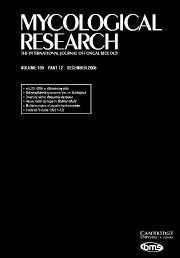Article contents
Systematic relationship of several controversial Cunninghamella taxa inferred from sequence comparisons of ITS2 of rDNA
Published online by Cambridge University Press: 01 July 1999
Abstract
The ITS2 of rDNA of eight strains representing five controversial species and a variety of Cunninghamella, i.e. C. bertholletiae, C. blakesleeana, C. elegans, C. phaeospora var. phaeospora, C. phaeospora var. multiverticillata, and C. polymorpha, were amplified through PCR. The PCR products were purified and their sequences determined. Sequence variations among the three strains of C. elegans and between the two strains each of C. bertholletiae and C. polymorpha are less than 5%, while those among the other three strains each representing a different taxon as well as among these strains and the above mentioned five strains representing two different species are 14–32%. Sequence variations between each of the eight Cunninghamella strains and Rhizopus stolonifer var. lyococcos, used as outgroup, are more than 70%. These results confirm the value of sequence analyses of ITS2 rDNA in the taxonomy of Cunninghamella. C. polymorpha is proven to be synonymous with C. bertholletiae, while the others are considered to be distinct taxa. Phylogenetic analyses of the sequence data by the neighbour-joining method generally reflect the systematic relationship of different species based on morphologic studies made by our research group. The three strains of C. elegans, and the two strains each of C. bertholletiae and C. polymorpha (a synonym of C. bertholletiae) are respectively clustered in the same clade with high confidence, while the strains representing the two varieties of C. phaeospora are also clustered in the same clade though with relatively low bootstrap value and long distance which supports the establishment of the distinct varieties.
- Type
- Research Article
- Information
- Copyright
- © The British Mycological Society 1999
- 5
- Cited by


